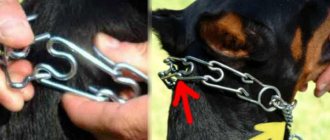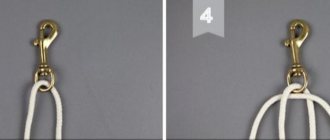What is better, a leash or a tape measure for a dog? Beginning dog breeders are often puzzled by this question when a small chewer appears in their home.
We will try to reveal all the advantages and disadvantages of both the leash and the tape measure. We hope this information will be useful and will help someone decide on the choice of equipment for walking with their furry pet.
Leash
There are many leash models. We have previously reviewed leashes. Read, there we listed their types and told what tasks they perform, and also talked about how to choose them depending on the purpose.
Cons of a leash
Let's start with the disadvantages:
- Walking your dog on a leash requires some skill and dexterity. You will have to constantly move the leash with your hands to adjust the desired length. In fact, it seems awkward and problematic at first. The tape may get tangled underfoot. But with daily practice, mastery of this instrument will come.
- If you do not tighten a loose leash in time, it can get dirty and contaminate your clothes.
- You will have to buy several leashes of different lengths. For walks, it is recommended to buy a 2-3 meter leash. But for training you will need a leash of 5 meters or more for the convenience of practicing commands at a distance.
Pros of a leash
Agree, we didn’t find many disadvantages of the leash. Let's look at the benefits:
- The leash is great for training and training. It is when walking on a leash that it is easier to teach the dog not to pull like a steam locomotive. Sometimes a leash is compared to a horse's reins. If the dog does not obey, it is easier to control the dog with a leash.
- Only on a long leash is the recall command practiced. You can pull your pet to you at any time. As positive results are achieved, the leash can be lengthened.
- When the recall command has been mastered, the young dog can be released into a free run along with a long leash that will drag along the ground. If a non-hearing dog does not respond to a call, it is easier to catch him by stepping on the leash with his foot and then pulling the dog towards you. So the pet understands that if the owner commanded “Come to me!”, you either come up and get a treat, or in any case you will find yourself next to the owner, only forcibly. The tail gradually realizes that there are no options and the command is executed in any case. After several training sessions, he will answer the call himself.
- With the help of a leash, it is easier to pull a four-legged animal or, if necessary, even pull it out of an unpleasant situation.
- A leash is more reliable than a tape measure. You can easily grab it without hurting your hand or other parts of your body.
- During walks, you can simply tie a long leash on your belt, thereby freeing up your hands.
Important! Never, not a single day, not a single walk until 1-2 years old, walk your dog without a leash. At this age the dog is considered a teenager. And like all teenagers, the furry prankster will make attempts to “test your strength,” break established rules, and explore the world around him. And you yourself know what the threat is. Don't give in to temptation. Take care of your pets. Otherwise, the watchdog may go for a walk away forever.
Which is better: a collar or a harness?
Another necessary item is a harness. It is not fastened to the neck, but rather covers the upper part of the dog's body.
The collar is bought for its practicality and the ability to control the animal during training and when learning commands. And the main advantage of the harness is the smooth distribution of the load on the body.
When the puppy pulls you forward, the harness will not tighten his neck or injure him. And in general, walking your pet on a harness gives you additional convenience. For example, the ability to lift it by the strap on the back. This is undoubtedly better than lifting the dog by the collar, risking injury to it.
Roulette
Perhaps the roulette is a phenomenal invention of mankind: it is a convenient and easy-to-use design. The four-legged animal seems to be “free swimming”, and at the same time under control. But is tape measure good for dogs? Does it allow you to completely control your pet? Let's look at the pros and cons of this device.
Disadvantages of Roulette
As with the leash, let's start with the disadvantages of the tape measure:
- By attaching a tape measure carabiner to the collar, you will have great difficulty teaching your pet not to pull while walking. Barbos in this case feels his advantage. He himself controls the direction of movement, regulates the length and freedom of movement. The dog begins to think that he is the one who makes the decision and has every right to do so. He gets used to pulling on the leash to get what he wants. The walk becomes simply a daily ritual of tugging.
- A dog located within the distance of an extended tape measure becomes uncontrollable. You lose contact with the four-legged animal and cannot control all its actions. Having complete freedom, the dog ceases to value it. She begins to think that this is her full right, and not a privilege. So you get a disobedient dog that does not listen to the owner, but achieves results. The dog decides: now I will pull the leash a little, and the owner will follow me. A dog that makes independent decisions ceases to recognize its owner as a leader.
- With a tape measure, you will not be able to suddenly stop and pull your pet towards you, since the tape measure only rewinds when the cord is loosened. What if the furry fidget jumps out onto a busy road, or is attacked by an angry stray dog? Of course, you will begin to sharply wind the tape measure, grabbing the cable or tape with all your hands. But this is fraught with injuries. This is another obvious disadvantage of roulette.
- Roulette is very dangerous for both the owner and the dog. If an unexpected situation occurs, the animal owner immediately grabs the rope to quickly get the pet out of trouble. There is no time to slowly wind up the tape measure. And here you cannot avoid wounded fingers, because the cables and tapes are made of quite durable and “cutting” material. A tape measure that rapidly winds or unwinds can cause injuries, cuts or burns to the skin (I know from my own experience). In our country, there are no statistics of injuries received by dog owners when using tape measures. But other countries have such data. For example, in the USA, in 2007, more than 17 thousand such visits to medical institutions were recorded. Due to the large number of lawsuits, Flexi, a leader in the production of this type of ammunition, began to accompany the products sold with extensive instructions and safety rules.
- A furry friend can also receive similar injuries: tongue injuries when trying to grab the cable with his teeth, as well as injuries to the back and limbs when the cable is tangled and wrapped around the dog, eye injuries from the carabiner when the leash breaks and is abruptly wound up.
- In addition, there are situations when a stretched tape measure suddenly slips out of the owner’s hands and begins to “chase” the four-legged animal at great speed. At the sight of the “monster” catching up, the dog begins to run away in panic, not noticing anything in its path. This is how dogs get lost and get hit by cars.
- Even if the watchdog does not start running, a heavy tape measure moving at full speed will definitely hit and scare the dog.
- The cable or tape itself is not as strong as a regular leash. They often break, especially when the tape measure is chosen incorrectly.
- If the tape measure suddenly breaks down and you and your pet are walking across the road, it can become an obstacle for your car or bicycle.
Why does a dog pull on a leash, what goals does it pursue, and how to wean your pet from this bad habit, read the article: Why does a dog pull on a leash when walking.
Pros of Roulette
As you can see, there are a lot of disadvantages of a roulette leash for a dog. Now let's look at the advantages:
- The tape measure is easy to use. It does not sag and does not stain clothes.
- The dog can walk itself, control the distance and go to a distant distance without any problems. Although, whether this can be considered a plus is highly doubtful.
- The dog can be stopped by just pressing a button with one finger. But, again, you won’t be able to quickly pull your pet towards you or pull it out of a difficult situation.
Well, that’s probably all the advantages of using roulette. In general it's convenient. But, if you are a beginner, then, using only a tape measure, you will always remain a beginner, and the dog will always remain untrained.
Manufacturing materials
Most often, standard leashes are made of leather, nylon or canvas. Of these, many owners prefer leather because of the aesthetic appearance of this material, but in practice this option turns out to be the most useless. Leather is a very heavy raw material, and therefore a product made from it turns out to be quite massive and uncomfortable. In addition, such leashes quickly become deformed, cracks and other damage form on them.
In this regard, nylon is more convenient, but also not particularly resistant. A nylon leash, even a rubberized one, can be used for small dogs and puppies, but for large breeds it is recommended to use canvas options. Tarpaulin is characterized by durability, it is difficult for a dog to gnaw it with its teeth, this material does not slip in the hand and is easily washed.
As already noted, it is better not to buy metal products. Yes, such a specimen looks very impressive and will harmoniously fit into the image of a graceful large dog, but it is better to use a chain only in places where beauty is more important than convenience, for example, at a dog show.
Results
So, what should you choose, a leash or a tape measure for your dog? Let's summarize:
- Controlling and controlling a dog using a tape measure is much more difficult than using a regular leash.
- Train the dog to call, the command “Near!” Only possible with a leash.
- Roulettes are more dangerous for both pets and their owners.
- If there is a strong pull, the tape measure can easily break.
- The cost of a good quality tape measure is several times higher than a regular canvas leash.
How to choose?
Before purchasing a leash, please read the following guidelines.
- Consider the size of the animal. The larger and more powerful the dog, the stronger the product will suit him.
- Before purchasing, make sure that the carbine and bolt are of sufficient strength and high quality.
- If you choose a leather leash, then buy a product whose edges are processed, otherwise the material will quickly get wet.
- If a leash is needed for a representative of a large breed, then you should choose a welded ring for a carabiner, and choose a cylindrical shape for the latch itself so that the dog does not unfasten it.
- For short educational measures, a noose leash is suitable. For small dogs, you can construct a noose in a couple of seconds yourself from a classic leash with a loop.
- To hold a medium and large dog, choose a leash 2-4 cm wide. Give preference to wicker or flat products, and flat ones should have a two-layer stitched structure. For miniature dogs, cute thin braided laces or rings are suitable, emphasizing the elegance and sophistication of representatives of elite breeds.
- For daily walks, a leash 2-3 m long is suitable; longer options are inconvenient, as the animal can get entangled in them. If the accessory is needed to practice commands, then give preference to products at least 6-8 m in length.
conclusions
A dog owner's arsenal should include both a tape measure and a leash. The use of one or another item may be advisable depending on certain conditions and specific situations.
For example, if you are training a dog, then we take a canvas leash to the site. We move along busy city streets among a large number of people and vehicles - we also use a leash.
If you are planning a relaxed walk with your pet around the house, along the shore of a pond, then a tape measure is quite suitable, and it will be even more convenient.
I would like to add. Using a tape measure is only possible if you are 100% sure of control over your pet. If your four-legged friend is poorly controlled, hyperactive and unpredictable, then it is better to put off the roulette. The imaginary ease of use and freedom of movement of the dog are fraught with more dangers than positive aspects.
Why choose?
The downside of tape measure, which absolutely all manufacturers are silent about, is the fact that the dog gets used to pulling on the leash. The cable is always slightly tense and the feeling of light pressure from the collar becomes familiar to the dog. Moreover, the pet will be completely bewildered if you start demanding not to pull on the leash.
A tape measure should not be used when training your dog for walks or walking next to you, as you will be rewarding your dog for (essentially) pulling on the leash. Even well-trained dogs should be walked periodically on a regular leash.
Conclusion: no need to choose between a tape measure and a leash! It is better to have both accessories and alternate them.
Source











